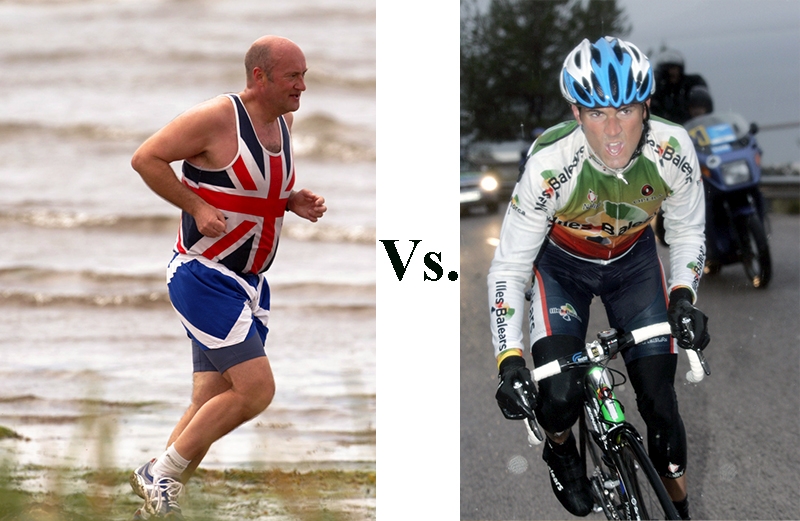You are viewing 1 of your 1 free articles. For unlimited access take a risk-free trial
Grappling with gravity: tackling the big climbs

How can cyclists tackling big climbs maximize performance? SPB looks at the physiology involved and provides practical advice
While cycling up a long hill is never easy, the buzz of conquering gravity followed by the thrill of a fast descent makes it one of the most rewarding experiences to be had in the saddle. In cycling, there’s no strict definition of ‘endurance climbing’ other than it involves sustained climbing over many minutes. This means that there’s an element of subjectivity; if you’re a recreational cyclist living in the lowlands of England, then even a 600ft climb could qualify as an endurance climb. However, for an elite cyclist living in the foothills of the Rockies or Alps, such a climb might be considered no more than a short blast!Energy demands
A more useful way of defining endurance climbing is to consider the energy demands. In an endurance climb lasting many or even tens of minutes, the primary source of energy is oxygen supplied from the body’s aerobic energy system. This means that rather than attacking furiously, a climb needs to be performed at a consistent, measured pace in order to prevent the accumulation of lactate, which would eventually result in extreme fatigue and a failure to continue.Of course, the fitter a cyclist, the faster he/she can climb a given hill, which means that some hills could be classed as an endurance climb for novice riders but more of a sprint for elite riders. For example, a 500ft climb with an average gradient of 9% might be completed at around 4.5mph by a novice rider, taking around 15 minutes – an endurance climb. For a pro rider sustaining much higher speeds, it could all be over in well under 4 minutes, which is not really an endurance climb! Once on the bigger climbs though, all cyclists will be endurance climbing no matter how accomplished they are in the saddle!
Physical challenges of endurance climbing
*Overcoming gravity
When riding in flat terrain, most of the energy is expended overcoming air resistance. While headwinds can be hard work, a cyclist can simply select a lower speed and drop down a cog or two yet still make reasonable progress. It’s also possible to lessen the impact of the wind – for example by lowering the body and tucking the arms in for a more ‘aero’ position. And when riding in a group, cyclists can ‘cheat’ the wind still further by all tucking in closely behind the rider in front (who will be doing the lion’s share of the work) and then taking turns at the front to ensure everyone gets a rest.However, when the road points upwards at the start of a long climb, things are very different because there’s no escaping the force of gravity. What’s particularly challenging for heavier riders is the penalty paid for transporting extra body mass up to the top of a climb. To illustrate this, let’s take two cyclists of equal fitness levels but one is a svelte and wiry 65kg lightweight rider while the second is a much more heavily built 85kg rider. How do their bodies respond when they begin a climb of 500m (1650ft)? With a 20kg weight difference, the simple laws of physics dictate that over the climb, our 85kg rider will expend an extra 100,000 joules of energy compared to the lighter rider.
Because energy is derived from oxygen metabolism, we can calculate that our 85kg cyclist actually has to consume around an additional 5.0 litres of oxygen to get his extra 20kgs of body mass up the hill. If it takes 15 minutes to climb the hill, that’s an extra 330mls of oxygen that need to be consumed each and every minute over and above that required by our lighter cyclist – a significant amount and the difference between being able to sustain a given pace to the top, or getting into oxygen debt and ending up by the roadside gasping for breath!
Figure 1 below provides an illustration of how, when the gradient increases, the proportion of energy required to overcome gravity rises dramatically. You can see how on the flat, a 75kg cyclist producing 300 watts of power expends the bulk (83%) of that power overcoming air resistance. No energy is required to overcome gravity. However, now look what happens at a very modest 6% gradient; here, no less than 80% of the cyclist’s energy is expended overcoming gravity, with just 10% used for overcoming air resistance. At a stroke, our cyclist’s body weight goes from being irrelevant to hugely important in determining how he/she copes with the climb ahead.
Figure 1: The relative energy contributions to overcome air resistance and gravity(1) (road bike, 300-watt power output)

NB: Assumptions for rider shown in box, lower RH corner. Typical expected speeds shown by blue line. The rolling resistance contribution (red) falls proportionately as speed falls whereas drivetrain losses remain fairly constant due to constant 300-watt power output.
*Heat stress
Another physical (and comfort) challenge of endurance climbing relates to the build up of heat you’ll experience during climbing, and the potential knock-on effects on cycling performance. As figure 1, shows, working at 300 watts power output propels you along at around 25mph (40kmh). A power output of 300 watts is very hard work – even for a fit rider – but the wind cooling effect on the body at those kinds of speeds is considerable. Unless you’re riding on a very hot day, overheating and dehydration is unlikely to be a problem, especially if you drink plenty of fluid.But once you begin a long, sustained climb, things change dramatically. Your workload is likely to increase, which results in more heat production. But at the same time, your speed will drop dramatically. On a modest 8% gradient working (very hard) at 300 watts, you’ll struggle to hold even 10mph. This lower speed dramatically reduces the wind cooling effect, so the body tries to compensate by increasing the rate of sweating. As this sweat evaporates and leaves the skin, it takes large amounts of heat with it – leaving the skin significantly cooler.
The problem is that if you’re wearing the right number of layers for cycling on the flat, you’ll quickly find yourself sweating profusely during a climb. And as the sweat drips into your eyes, not only will you be feeling uncomfortable, the attendant rise in your body’s core temperature will make it harder to keep up the work rate. Indeed, one study found that just 16.5 minutes of simulated climbing in heat stress conditions was enough to raise core temperatures by nearly 1C, resulting in 16% less power, higher heart rates and much higher rates of perceived exertion(2). In other words, the heat generated by the hard work of climbing will make that effort feel even harder and more uncomfortable than it already is!
Pacing a climb
How should cyclists best pace a climb? This of course will depend on many factors, the most important of which is fitness level and power-to-weight ratio (an extremely important predictor of climbing performance). There are a number of ways to guide climbing pace. These include:- Heart rate – because there’s a fairly linear relationship between heart rate, oxygen consumption and work rate, heart rate can be used as a pacing guide (with a heart rate monitor). By monitoring your heart rate, you can ensure that you stay mainly in the aerobic zone without crossing into the anaerobic zone, where fatiguing lactate starts to rapidly accumulate, forcing you to slow down or even stop. Because climbing is hard work and the gradient is rarely constant, heart rates may occasionally stray above 85% MHR. If fitness levels are high, this is unlikely to be a problem; however, once 90%+ MHR is achieved, there may be a price to pay!
- Power output – Accurate power measurement devices (eg fitted to hubs, pedals, bottom brackets) have become steadily more affordable. As long as you know the maximum sustainable power output for a given time period is known, and roughly how long the climb is going to take, cyclists can use that figure to guide pace and effort level. The advantage of power measurement is that over time, cyclists can see the progression as their maximum sustainable power rises, which is very motivational.
- VAM – The term VAM is derived from the Italian ‘Velocità Ascensionale Media’, which translated is mean (average) ascent velocity and leads to the English acronym Velocity Ascent Mean – ie A VAM figure equates to the average number of vertical metres climbed per hour, so for example, a VAM of 1150 for a climb means that the average vertical ascent rate was 1,150 metres per hour. VAM is useful because it also relates to a rider's power output per kilogram of body mass – probably the most important determinant of success in endurance climbing. As a cyclist gets better at climbing, VAM for a given climb will increase. It’s also useful as it allows direct comparisons between different climbs; as a rule of thumb, every 1% increase in average gradient decreases VAM by 50. So for example, a VAM of 1700 on a climb of 8% gradient is a performance equivalent to a VAM of 1650 on 9% gradient. Data on VAM is readily available from cycling computers or by using smartphone GPS apps and uploading to sites such as Strava.

Riding position and pedaling cadence
During a long climb, most cyclists find it less fatiguing to remain seated. It’s true that (because of additional muscle recruitment) you can generate more force on the pedals when standing out of the saddle. However, studies show that for a given speed, the extra use of the upper body muscles will lead to higher heart rates and breathing rates(3). That said, there are some circumstances when you might want to get out of the saddle during a climb:- During a long climb, temporarily getting out of the saddle and standing while you pedal gives you the opportunity to stretch out and give the lower back muscles a bit of a rest. If you want to maintain the same rhythm/cadence however, you might need to move up a gear to compensate for the extra force you can generate in the standing position.
- Most climbs don’t have a uniform gradient; if you see a short steeper section ahead, you may want to get out of the saddle and try and maintain your speed, rather than drop another gear.
- At the end of the climb when the summit is approaching, you can get out of the saddle and give it all you have because you have the option of recovering down the other side!
In terms of your optimum pedaling cadence, it’s observed that during a long climb, many cyclists tend to drop their rpm. Again, research suggests that this actually quite a good approach - numerous studies show that slower cadences (under 80rpm) are more energetically efficient than higher ones(5). Despite this, the greater forces needed to cycle uphill mean that while a lower cadence may be more energetically efficient, it might result in more lactate accumulation. Given that a significant accumulation of lactate will slow you down significantly and may even force you to stop, losing a little efficiency by using a higher cadence (which reduces the forces on muscle fibers) could a price worth paying. What does this all mean in practice? Well, during a long climb, try to remain seated and adjust your gearing so that you can continue to pedal rhythmically without the sensation that your leg muscles are getting heavier and heavier, or burning.
When power just isn’t enough
As discussed, when climbing, what really matters is the amount of power a cyclist can produce in relation to his/her bodyweight – ‘power-to-weight ratio’ – usually expressed in watts per kilogram. Over a 20-minute period, a fit club rider can typically sustain a power output of around 3 watts per kilo of bodyweight. For elite pro riders, this can be as high as 6.5 watts per kilo – a figure that a club rider might struggle to sustain for 20 seconds.Table 1: Power-to-weight ratio (watts/kg) for a range of rider weights and power outputs
| 120w | 150w | 180w | 210w | 240w | 270w | 300w | 330w | 360w | 390w | |
| 45kg | 2.7 | 3.3 | 4.0 | 4.7 | 5.3 | 6.0 | 6.7 | 7.3 | 8.0 | 8.7 |
| 50kg | 2.4 | 3.0 | 3.6 | 4.2 | 4.8 | 5.4 | 6.0 | 6.6 | 7.2 | 7.8 |
| 55kg | 2.2 | 2.7 | 3.3 | 3.8 | 4.4 | 4.9 | 5.4 | 6.0 | 6.5 | 7.1 |
| 60kg | 2.0 | 2.5 | 3.0 | 3.5 | 4.0 | 4.5 | 5.0 | 5.5 | 6.0 | 6.5 |
| 65kg | 1.8 | 2.3 | 2.8 | 3.2 | 3.7 | 4.1 | 4.6 | 5.0 | 5.5 | 6.0 |
| 70kg | 1.7 | 2.1 | 2.6 | 3.0 | 3.4 | 3.8 | 4.3 | 4.7 | 5.1 | 5.6 |
| 75kg | 1.6 | 2.0 | 2.4 | 2.8 | 3.2 | 3.6 | 4.0 | 4.4 | 4.8 | 5.2 |
| 80kg | 1.5 | 1.9 | 2.2 | 2.6 | 3.0 | 3.4 | 3.8 | 4.1 | 4.5 | 4.9 |
| 85kg | 1.4 | 1.8 | 2.1 | 2.5 | 2.8 | 3.2 | 3.5 | 3.9 | 4.2 | 4.6 |
| 90kg | 1.3 | 1.7 | 2.0 | 2.3 | 2.7 | 3.0 | 3.3 | 3.7 | 4.0 | 4.3 |
| 95kg | 1.2 | 1.6 | 1.9 | 2.2 | 2.5 | 2.8 | 3.2 | 3.5 | 3.8 | 4.1 |
As a consequence, endurance climbing is particularly challenging for a heavier rider, who will have more mass to lug uphill – even if that rider can sustain relatively high power outputs. To illustrate this, look at table 1. A 90kg rider might be able to sustain an impressive 360 watts of power output for 20 minutes. But with a power-to-weight ratio of 4.0 watts/kilo, he/she would be outperformed during a long climb by a 65kg rider with a sustainable power output of 300 watts (power-to-weight ratio of 4.6 watts/kilo).
A good example of this is pro cyclist Magnus Bäckstedt (see box 1), the 2004 winner of the Paris-Roubaix race, and who at 94kg was one of the heaviest ever riders to have taken on the Tour de France in 2005. If you are a heavier rider, you need to accept that even if you have high levels of fitness, endurance climbing will be more challenging for you than for your featherweight contemporaries. Remember though that your extra weight means you can descend faster and you can use any power advantage to make up time in the flatter sections! You’ll also fare very well when competing in mainly flat time trials and races.
Box 1: Magnus Bäckstedt

An accomplished rider on the flat, Bäckstedt was the Paris-Roubaix winner in 2004 and came second on the 7th stage of the 2005 Tour. However, in 2008, he was eliminated for being too slow on one of the mountain stages. Bäckstedt’s maximum sustainable power output compared very favorably with his contemporaries, but his high body mass penalized his power-to-weight ratio. As Bäckstedt remarked afterwards, “With 100km to go, I was going OK. I could see the numbers on the power meter and they were normal for the kind of effort you need to get to the finish on your own, inside the time limit. I think I would have made it too, but there was a real steep hill just before the finish and my breathing and legs went. It was like I shut down from the waist down and I ended up four minutes outside the cut-off.”
References
- Validation of a Mathematical Model for Road Cycling Power’, J Appl Biomechanics 1998; 14:276-291
- J Appl Physiol. 2015 May 15;118(10):1258-65
- Med Sci Sports Exerc. 2002 Oct;34(10):1645-52
- Eur J Appl Physiol. 2012 Jul;112(7):2433-41
- Eur J Appl Physiol (2011) 111:2885–2893
Newsletter Sign Up
Testimonials
Dr. Alexandra Fandetti-Robin, Back & Body Chiropractic
Elspeth Cowell MSCh DpodM SRCh HCPC reg
William Hunter, Nuffield Health
Newsletter Sign Up
Coaches Testimonials
Dr. Alexandra Fandetti-Robin, Back & Body Chiropractic
Elspeth Cowell MSCh DpodM SRCh HCPC reg
William Hunter, Nuffield Health
Keep up with latest sports science research and apply it to maximize performance
Today you have the chance to join a group of athletes, and sports coaches/trainers who all have something special in common...
They use the latest research to improve performance for themselves and their clients - both athletes and sports teams - with help from global specialists in the fields of sports science, sports medicine and sports psychology.
They do this by reading Sports Performance Bulletin, an easy-to-digest but serious-minded journal dedicated to high performance sports. SPB offers a wealth of information and insight into the latest research, in an easily-accessible and understood format, along with a wealth of practical recommendations.
*includes 3 coaching manuals
Get Inspired
All the latest techniques and approaches
Sports Performance Bulletin helps dedicated endurance athletes improve their performance. Sense-checking the latest sports science research, and sourcing evidence and case studies to support findings, Sports Performance Bulletin turns proven insights into easily digestible practical advice. Supporting athletes, coaches and professionals who wish to ensure their guidance and programmes are kept right up to date and based on credible science.











